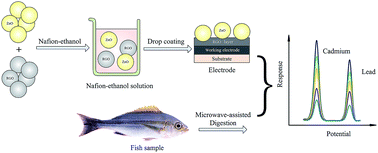A ZnO–RGO-modified electrode coupled to microwave digestion for the determination of trace cadmium and lead in six species fish†
Abstract
Herein, a composite of a ZnO nanoparticle and reduced graphene oxide (RGO) was employed as a sensing interface in a practical electrode for the determination of cadmium (Cd2+) and lead (Pb2+). A suspension comprising the ZnO nanoparticle and RGO was synthesized via the wet-chemical method. The ZnO–RGO-modified electrode was obtained by drop-coating the prepared suspension onto a screen-printed electrode. The modification was validated via scanning electron microscopy and cyclic voltammetry. The properties of the sensor were studied by analyzing digested fish samples at various settings and gradually increasing concentrations. Stripping responses were significantly improved by optimizing the digestion factors including acid mixture ratio, microwave power, and digestion time. Signal losses during digestions were less than 25%. The detection limits of the electrode for Cd2+ and Pb2+ were as low as 0.16 and 0.17 μg L−1, respectively, in the matrix of the real sample. Finally, this method was applied to determine trace Cd2+ and Pb2+ in six species of fish, and the obtained results were in good agreement with those obtained via ICP-MS.


 Please wait while we load your content...
Please wait while we load your content...